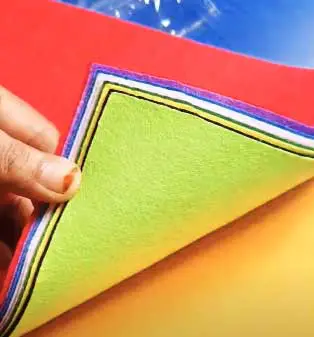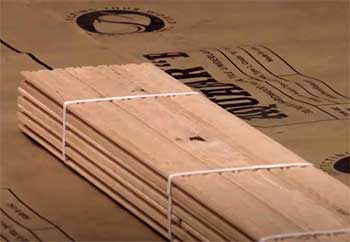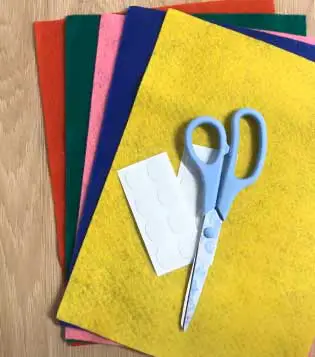Are you sick and tired of interior moisture damage in your house?
Think of it as a war, and you need the right weapon to win. I’ve been there are, and I will give you a detailed review on Aquabar “B” vs. felt paper.
To be honest, both of them are pretty good, while Aquabar B is a new product compared to felt paper that has been around for a long time. But you can only choose one when you know their features and differences.
Let’s check them out.
A Quick Comparison Table
Repairing moisture damage or installing a damage prevention sheet is a huge decision that requires a meticulously selected product. It is only possible when you know details on the best available options.
Here is a quick comparison table between Aquabar B and Felt paper:
| Aspects | Aquabar B | Felt Paper |
| Special Feature | SEMI-PERMEABLE CLASS II MEMBRANE | Asphalt-saturated and works as a Moisture Barrier |
| Composition | Grade B Asphalt Laminated Duplex Type Kraft Paper | Mixture Of Sawdust And Recycled Corrugated Paper |
| Performance | Extremely High Performing | High Performing |
| Size & Weight | 36” X 167’36” X 334’Weight: 3 lbs/ 100 Sq Ft | 15-Asphalt Felt: 7-14 Pounds.30-Asphalt Felt: 16.5-17 Pounds |
| Availability | Widely Available | Widely Available |
Key Differences Between Aquabar “B” And Felt Paper

Fortifiber Building System Group produces a well-performing and effective moisture vapor retarder Aqua B.
It has been around for not so long.
Yet its vapor resistance performance in various interior construction has proceeded it.
On the other hand, Felt paper has been around for hundreds of years, primarily used for roofing.
Now people use them as underlayment for walls too.
Let’s dive deeper:
- Features
Aquabar B is a high moisture-resistant sheet with very low vapor permeance.
Its semi-permeable class II membrane sheet features easy installation under your wall, and besides, you can clean it effortlessly.
In addition to all these, Aquabar B has passed the California CA01350 Indoor Air Quality Requirement test.
On the other hand, saturated with asphalt, felt papers work as vapor barriers. Initially, it was designed for roofing. But authorities have allowed it to be used for wall underlayment as well.
Felt paper has two variants. One is 15 asphalt felt, and the other is 30 asphalt felt.
- Composition
Being a semi-permeable class II vapor retarder or cleavage membrane, Aquabar B is used under wooden floors and behind or below tiles substrates. It is a Kraft paper with 30/30/30 grade B asphalt lamination.
On the contrary, Felt paper is also asphalt-saturated, and people have used it for centuries. With a long legacy, traditional clothing felt was widely available for roofing, from recycled cotton rags.
But modern-day asphalt-saturated felt papers are made from sawdust and recycled corrugated paper, making them lightweight and durable.
- Performance

Forifiber Building Solution Group has more than seventy-five years of history and expertise.
With this expertise and proven performance, they have designed Aquabar B.
It features a superior vapor retarding under the wooden floor and wall that helps slow down the moisture vapor.
Besides, they work like a slip sheet and minimize dust and noise. It is tested for and thereby rated as moderate water-vapor resistance.
In contrast, felt papers are well-known for absorbing water and then slowly evaporating the moisture to the exterior. A dry asphalt felt paper’s permeance is 5 perm, but a wet asphalt felt’s permeance is as high as 60 perms.
So, if water passes through a felt paper, it will soak it up and gradually dry to the exterior.
- Size and Weight
Size and weights are very important metrics for transportation and installation. Aquabar B is available in two sizes. The 36 inches wide and 167 feet long sheet can cover up to 500 square feet, while the 36 inches by 334 feet sheet can cover a 1000 square feet area.
With a 3 Ibs/ 100 square feet weight, Aquabar B is way lighter than its competitor felt paper.
Talking of which, felt paper offers two weights for its two variants. The 15 asphalt felt weighs around seven to fourteen pounds per 100 square feet.
But the 30 asphalt felt paper weighs between 16.5 and 17 pounds for the same 100 square feet.
- Availability
Although Aquabar B is comparatively new, its manufacturer isn’t. Being on the market for a long time has allowed them to create a robust supply chain. Aquabar B is available on retails shops and to distributors nationwide.
Similarly, felt papers are also widely available in the market. Many manufacturers make them, and thus you will get them at your doorstep.
- Impact Sound Insulation

No one wants to hear loud thumping noises when walking above a hardwood floor.
Quality underlayments can dampen these impact sounds for a quieter home.
The Aquabar “B” underlay has an IIC rating of 56 and STC rating of 54 for excellent sound deadening.
Its closed cell polymer film blocks impact vibration transmission far better than porous felt.
There is no paper crinkling noise potential either.
So Aquabar “B” ranks high for sound insulation if this is important for your project.
Standard felt paper has no sound insulation specifications. Being thin and stiff, it offers very little acoustic damping benefit. If upstairs neighbors or home theater sound privacy are concerns, felt would not be a good underlay choice.
Aquabar “B” has vastly superior impact sound insulation over basic felt.
- Softness and Flexibility
A soft underlay provides a gentle cushion below the hardwood flooring to prevent surface noises when walked on while allowing slight board movement. This cushioning also helps smooth out minor subfloor imperfections and adds comfort underfoot. Proper balance between softness and firm support is key however.
Aquabar “B’s” cross-linked polymer film gives it a flexible, semi-rigid structure able to conform around floor imperfections. This cushions floor boards beautifully while still giving proper structural support.
It offers the ideal firm yet forgiving cushion for top wearing surface performance. Brands like Schluter Systems tout Aquabar’s ability to make floors quieter, warmer and more comfortable.
By comparison, standard felt paper is very thin with no cushioning ability. It lays flat and stiff over subfloor surfaces. So thin felt can allow imperfections like bumps or cracks to telegraph through floor boards resulting in surface irregularities underfoot. This also provides no sound damping or temperature insulation benefits.
If underfoot softness is desired, Aquabar “B” has a clear cushioning advantage over no-frills felt.
- Odor Potential
Off-gassing smells from underlayment materials is an important health consideration for indoor air quality. Aquabar “B” is rated low VOC and contains no harmful volatile chemicals or plasticizers. So no odors occur with its installation or while in use. This keeps indoor air fresh and breathable below the floors.
Standard felt paper is made from pressed wood fibers that release acids as they degrade over time. In moist environments, mildew growth on the paper creates unpleasant musty smells coming up from underneath flooring. These odors often require removal of floor boards for elimination if ventilation cannot dry out the felt quickly.
If indoor air quality is a concern, Aquabar “B” will not create unpleasant odors like damp felt can.
- Cost Comparison
There is no contest when it comes to the price difference between these two underlayment products. A basic felt paper roll 75 feet long by 36 inches wide can cost as little as $25. This makes it very affordable for supplying large floor jobs. But you get only bare bones moisture protection.
Aquabar “B” costs significantly more, averaging around $100-150 for a 75 foot roll. So it offers superior vapor barrier performance and acoustic insulation but at a premium price point. Budget is often the determining factor for many homeowners and flooring installers.
If low cost is the priority, basic felt paper easily wins. But Aquabar “B” brings advanced vapor protection and cushioning at a higher price.
- Ease of Installation
Underlayments that go down quickly and easily save labor time and headaches during the flooring installation process. Felt paper unrolls smoothly in long wide sheets and lays flat into place prior to installing floor boards. No special fastening is required which makes this a simple addition.
Aquabar “B” also comes in large rolls for quick convenient coverage across subfloors. It has a self-adhering overlap strip along one edge so each successive row seals securely. This gives reliable moisture protection and prevents buckling. So Aquabar “B” takes only minutes longer to properly install and seal.
Both Aquabar and standard felt can be installed quickly with little fuss or extra steps involved.
Which One Is Best For You?
It shouldn’t be hard for you to decide what you want with all the information. But if you are still in a dilemma, take my suggestion and go for Aquabar B.
Not only does it has all the superior features, but it also represents higher quality and materials.
Still not convinced? Look for how to install them. You will find that Aquabar B is far easier to install than felt papers.
Frequently Asked Questions (FAQ)
Aquabar B is a laminated asphalt paper that works as tile and floor underlayment. It is consists of two layers of Kraft paper and is a highly effective moisture vapor retarder.
Aquabar B is a vapor retarder, not a vapor barrier or a waterproof membrane. You cannot use this asphalt laminated Kraft paper for waterproofing.
Aquabar B is a vapor retarder. Because of asphalt lamination, you can use this Kraft paper as a moisture retardant membrane under walls or tiles.
With a 16.4 kilonewton force, the hardest flooring material is Lapacho or lpe. However, they are challenging to find.
Conclusion
Selecting moisture damage prevention sheets is a huge decision and requires a lot of consideration. But I hope my Aquabar “B” vs. felt paper review comes in handy.
I’ve already made it easier for you to decide with all the necessary information.
But the bottom line is, buy one that suits your house the most. I’ve given the information, and now it’s your call.
